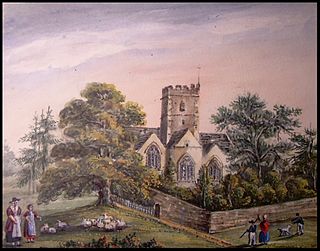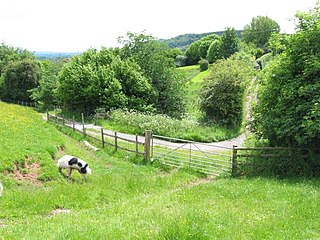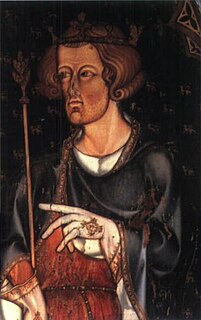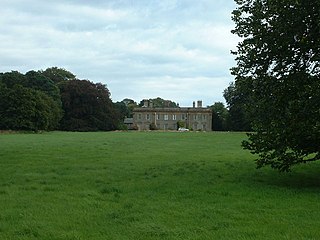
Brecon, archaically known as Brecknock, is a market town in Powys, mid-Wales. In 1841, it had a population of 5,701. The population in 2001 was 7,901, increasing to 8,250 at the 2011 census. Historically it was the county town of Brecknockshire (Breconshire); although its role as such was eclipsed with the formation of the County of Powys, it remains an important local centre. Brecon is the third-largest town in Powys, after Newtown and Ystradgynlais. It lies north of the Brecon Beacons mountain range, but is just within the Brecon Beacons National Park.

Powis Castle is a medieval castle, fortress and grand country house near Welshpool, in Powys, Wales. The seat of the Herbert family, Earls of Powis, the castle is known for its formal gardens and for its interiors, the former having been described as "the most important", and the latter "the most magnificent", in Wales. The castle and garden are under the care of the National Trust. Powis Castle is a Grade I listed building.

Dafydd ap Llewelyn ap Hywel, better known as Dafydd Gam, anglicized to David or Davy Gam, was a Welsh warrior, a prominent opponent of Owain Glyndŵr. He died at the Battle of Agincourt fighting for Henry V, King of England in that victory against the French.

Three Cocks or Aberllynfi is a village near Glasbury in Powys, Wales. The Welsh name refers to the mouth of the Afon Llynfi which enters the River Wye a mile from the village. The nearest town is Hay-on-Wye some 5 miles (8.5 km) to the North East.

Raglan is a village and community in Monmouthshire, south east Wales, United Kingdom. It is located some 9 miles south-west of Monmouth, midway between Monmouth and Abergavenny on the A40 road very near to the junction with the A449 road. The fame of the village derives from its castle, Raglan Castle, built for William ap Thomas and now maintained by Cadw. The community includes the villages of Llandenny and Pen-y-clawdd. Raglan itself has a population of 1,183.

St Michael's College was an Anglican theological college in Llandaff, Wales. The college was founded in Aberdare in 1892, and was situated in Llandaff from 1907 until 2016. Among its many alumni was the poet R. S. Thomas. The original building on the site was a house constructed for himself by John Prichard. After his death, that building was incorporated into the newly-founded St Michael's College, which was built mainly to the designs of F. R. Kempson between 1905-1907. In the late 1950s, a chapel was built by George Pace. The college closed as a residential training college in 2016 and was re-established as the St Padarn's Institute which organises theological training for the whole of the Church in Wales.

Treberfydd House is a Gothic Revival house, built in 1847–50 just south of Llangorse Lake in the Brecon Beacons National Park in South Wales, to the designs of architect John Loughborough Pearson. It remains a private home to the Raikes family and is a Grade I listed building.

Y Gaer is a municipal structure in Glamorgan Street, Brecon, Powys, Wales. The complex, which includes a museum, an art gallery and a library and incorporates a structure which was once the shire hall for Brecknockshire, is a Grade II* listed building.

Gwladys ferch Dafydd Gam was a Welsh noblewoman. She was the daughter of Dafydd ap Llewelyn ap Hywel, otherwise known as Dafydd Gam, who was killed at the Battle of Agincourt in 1415.

Sir Roger Vaughan of Bredwardine, also known as Roger Fychan or Roger the younger, was a Welsh gentleman, described as having possessed wealth, rank, and high respectability. Roger's seat, Bredwardine Castle, is estimated to have been a strong and formidable fortress, located on the banks of the Wye river in Herefordshire, two miles north of Moccas Court. Bredwardine Castle is thought to have furnished much of the material for the building of Moccas Court.

LlanvihangelCourt, Llanvihangel Crucorney, is a Tudor country house in Monmouthshire, Wales. The architectural historian John Newman, in his Gwent/Monmouthshire volume of The Buildings of Wales series described the court as "the most impressive and richly decorated house of around 1600 in Monmouthshire". The origins of the house are medieval, with a traditional date of construction of 1471. The building was given its present appearance by a substantial enlargement and re-casing of circa 1600 by Rhys Morgan, of the family of the original owners. In the very early 17th century it was owned briefly by Edward Somerset, 4th Earl of Worcester.

The conquest of Wales by Edward I, sometimes referred to as the Edwardian Conquest of Wales, to distinguish it from the earlier Norman conquest of Wales, took place between 1277 and 1283. It resulted in the defeat and annexation of the Principality of Wales, and the other last remaining independent Welsh principalities, by Edward I, King of England.

Monmouthshire is a county and principal area of Wales. It borders Torfaen and Newport to the west; Herefordshire and Gloucestershire to the east; and Powys to the north. The largest town is Abergavenny, with other large settlements being Chepstow, Monmouth, and Usk. The present county was formed under the Local Government (Wales) Act 1994, and comprises some sixty percent of the historic county. Between 1974 and 1996, the county was known by the ancient title of Gwent, recalling the medieval Welsh kingdom. The county is 850 km2 in extent, with a population of 95,200 as of 2020.

In the United Kingdom, the term listed building refers to a building or other structure officially designated as being of special architectural, historical, or cultural significance; Grade I structures are those considered to be "buildings of exceptional interest". Listing was begun by a provision in the Town and Country Planning Act 1947. Once listed, strict limitations are imposed on the modifications allowed to a building's structure or fittings. In Wales, the authority for listing under the Planning Act 1990 rests with Cadw.

Moynes Court is a Grade II* listed building in the village of Mathern, Monmouthshire, Wales, about 3 miles (4.8 km) south west of Chepstow. An earlier building was rebuilt as a private residence by Francis Godwin, Bishop of Llandaff, in about 1609/10, and much of the building remains from that period. Its grounds contain earthworks thought to be the foundations of an earlier moated manor house. The gatehouse to the court has a separate Grade II* listing.

Ffynone is a mansion and estate near Boncath, Pembrokeshire, Wales, in the parish of Manordeifi. The original Georgian design was by architect John Nash and later remodelled by Inigo Thomas.
Penpont is a seventeenth-century Grade I listed manor house in the Usk valley between Brecon and Sennybridge in Powys, Wales. It was built by Daniel Williams on the site of, and perhaps incorporating, an earlier house, Abercamlais-isaf. The frontage dates from 1815. Penpont Bridge, a grade II* listed structure, spans the Usk by means of four segmented stone arches. The gardens at Penpont are influenced by Repton but have a long history from the seventeenth century with the addition of a celebrated Green Man maze in recent years. Less than half a mile upstream is Abercamlais with which comparisons are made, the two houses having some shared history.

Leeswood Hall is a country house in Leeswood, Flintshire, Wales. Dating from 1742, it was built for George Wynne, the design being attributed to Francis Smith. Construction reputedly cost £40,000. The hall is a Grade II* listed building. To the northwest of the hall stand the White Gates, which have their own Grade I listing. The gates terminate the view from the hall across the lawns, an early and rare example of 18th century parkland design by Stephen Switzer, and a Grade I listed landscape of national significance.

The Church of St Anno in Llananno, Powys, Wales, is a redundant church dating from the 14th century. Its medieval rood screen is considered "one of the great treasures of Welsh craftsmanship". A Grade II* listed building, the church is now in the care of the Friends of Friendless Churches.



















